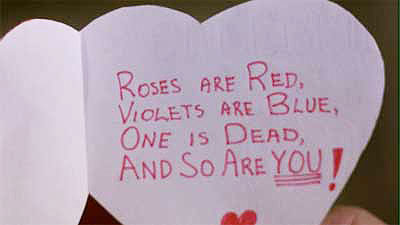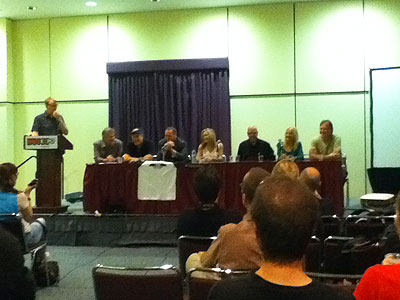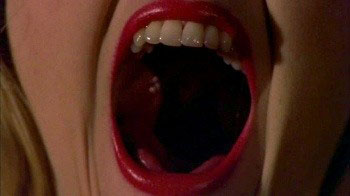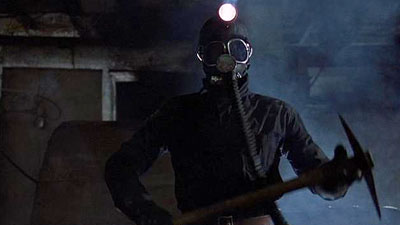We Were Having A Party And Harry Warden Started Killing Everybody: 30 Years Of My Bloody Valentine
Published on September 29th, 2011 in: Canadian Content, Conventions/Expos, Halloween, Horror, Movies |
If you’ve haven’t seen the original version of My Bloody Valentine from 1981, you’re missing out. If you haven’t seen the uncut version, you’re definitely missing out. The 2009 reissue contains almost five minutes of footage that wasn’t in the original, theatrical release. Five minutes doesn’t sound like a whole lot, but after an hour spent with members of the cast and crew of the film, I now understand why they meant so much.
As part of the Festival of Fear, Rue Morgue‘s Paul Corupe gathered several members of the cast and crew for a 30th Anniversary reunion: Neil Affleck (“Axel Palmer”); Paul Zaza (composer); George Mihalka (director); Lori Hallier (“Sarah”); Bob Presner (line producer); Helene Udy (“Sylvia”); and Jim Murchison (“Tommy”).
Director George Mihalka gave a bit of history as to how the movie came into being. He was working on a comedy script with line producer Bob Presner at the time, when producer John Dunning told him about a treatment writer Stephen Miller had developed for a slasher picture.

After Mihalka and screenwriter John Beaird had fleshed out the script, they needed a location. Since the movie was supposed to take place in a mining town, Mihalka was thrilled to find a recently-closed mine in a small town, the Princess Colliery mine located in Sydney Mines on Cape Breton. It was dingy and spooky and atmospheric.
Shooting a movie in a mine presented a unique set of challenges. After they’d chosen the location, the townspeople were so happy they cleaned up the mine for them. When the film crew arrived, they were aghast that the formerly perfectly filthy mine was now clean and sparkling! So they spent some of the film’s budget to make it dirty again.
In addition, taking the cast and crew 2,700 feet (900 meters) underground each day of shooting took several hours since only a few people could go down at a time. Plus, each time there was a dangerous build up of methane gas (something which is actually mentioned in the movie itself), they’d have to evacuate everyone, sometimes three or four times a day!.
Lighting posed another problem, especially when dealing with potentially explosive gas. They couldn’t use standard film lights, which are upwards of 1,000 watts. They were forced to use “inky” lights (about 100 watts) and 25-watt light bulbs. And candles. Lots and lots of candles.
This added another layer of difficulty onto the production. Regular analog light meters couldn’t measure the differences between two- and four foot-candles, so they had to acquire a digital light meter, a fairly recent invention at the time. Mihalka praised Director of Photography Rodney Gibbons saying that he did an amazing job lighting the movie with “nothing.”
So one set of problems solved and then . . . because of the film’s holiday theme, they had to have it finished and ready for a Friday the 13th release date (since Valentine’s Day was the next day). If they missed that deadline, they wouldn’t get paid. Unfortunately, it took a week to get each set of rushes (something which would normally take a day) because they were using a type of film stock that could only be processed in New York.
The biggest problem of all turned out to be the content of the movie. On that subject Mihalka said, “I prefer not to speak ill of the dead except for Jack Valenti.” Valenti was the President of the MPAA for almost 40 years and the same man who had created the ratings system in the US in 1968. He felt the film was too violent and couldn’t be released. So producers John Dunning and Andre Link sent a “slash print” (rough cut) to the MPAA with the film’s editors. They returned with a verdict: “they want to cut out all the special effects.”

As a slasher film, My Bloody Valentine had quite a few special effects. Yet, Mihalka added, they’d hired The Burman House, responsible for the great make-up used in the Planet of the Apes films. At the time, most gore was filmed in three or four shots to incorporate both the actors and the effects, but Burman had devised some extremely creative one-shot effects. To avoid destroying their creation entirely, the crew started to cut an average of ten frames at a time from the “offending” scenes, but they also had to cut the master sound to match, and then get the approval of the MPAA.
All of these roadblocks, plus a seven-week shooting schedule, meant that there were actually two crews shooting consecutively, with Mihalka and many others working almost 24-hour days. All their ingenuity and hard work paid off, though, because My Bloody Valentine is not just a Canadian classic, it’s one of the best slasher movies of all time. The setting, the story, and the characters are all far more compelling than other slashers, where you either don’t care about the characters (sorry Friday the 13th!) or hate them outright (The Burning).
As for the cast, they had their own memories of the film. Lori Hallier, who played Sarah, wanted to be a “dramatic actress of the theater,” and when she was cast in the movie, she needed special permission to shoot since she was still in theater school. She laughed at her youthful naïveté, saying that in order to seem convincingly terrified, she and fellow actress Cynthia Dale (who played Patty) were running around set so that they’d be out of breath. They were told they should probably pace themselves because they “might have to do some acting.” Hallier said she loved playing a brave female and particularly enjoyed the scene where she slaps Patty in the face!
Neil Affleck, who played Axel, admitted he’s been getting compliments for years over something he didn’t actually do in the movie: enact the scenes of crazy “Harry Warden” in the miner’s mask. The killer was actually played by Liam Blackwood (a.k.a. Peter Cowper). In fact, although the central cast knew at the beginning that one of them would turn out to be the killer, they didn’t know which one. But when Affleck was sent to the make-up department to be fitted for a prosthetic arm, he figured it out pretty quickly.

As Tommy, Jim Murchison played one of the survivors, one of the cast members who never had to film any scenes in the mine. Yet Mihalka wanted everyone to go down there at least once to get the feeling of working in a mine. On his one trip, Murchison was critically exhausted and covered with soot, amazed at the fact that real miners endure such conditions for eight to ten hours at a time.
Despite not filming in the mine, Murchison noted that his one “big scene” was like theater, as all the townspeople had lined the streets when he exclaimed, “Chief! We were having a party and Harry Warden started killing everyone!” A bit of comic relief in an otherwise grim movie.
Everyone heaped praise on the scene where the clothes fall on Sylvia, played by Helene Udy, before she is killed. Helene enthused that, “it’s fun dying when it’s not true.” Some critics at the time called that part contrived, but what they didn’t realize was the contraption was the actual device miners used to dry their clothes.
As for the oddly haunting closing theme song, “The Legend of Harry Warden,” it was Paul Zaza’s creation. He didn’t want a disco song over the credits like Prom Night, so he basically stole Gordon Lightfoot’s “The Wreck of the Edmund Fitzgerald.” The lyrics are a recounting of the events of the movie as sung by his friend John McDermott. What amazes and amuses him is that filmmakers Eli Roth and Quentin Tarantino love the song so much, they allegedly get drunk and play it.
An audience member wanted to know how much Moosehead they drank on set. Everyone laughed but Bob Presner revealed that they had actually arranged a deal with Moosehead for product placement in exchange for two 24-cases of beer a day! Mihalka thought it was a “subversive” touch, since the movie wasn’t supposed to seem “Canadian.”
Despite the stumbling blocks they encountered, everyone praised the town and its residents, saying that they’d love to go back one day and thank everyone personally. One of the attendees at the panel, a resident of the area, stood up and thanked the cast and crew, insisting that the movie fostered a huge amount of pride, something that still remains today.
Mihalka mentioned that he hoped to create a genuine working class feel with My Bloody Valentine, and if you’ve seen the movie, you know he succeeded. And if you haven’t seen the movie, be sure to look for the 2009 Special Edition in either DVD or Blu-Ray. Although some of the scenes included in the nine minutes that were cut are gone forever (like Harriet and Mike’s death), the restored five minutes make a huge difference.

If you live in the Toronto area, you’re in luck! Director Guillermo del Toro will be hosting a special screening of My Bloody Valentine at the TIFF Bell Lightbox on Monday, October 31 at 6:30 p.m. Director George Mihalka will be in attendance, showing the deleted scenes after the screening. To get tickets, please visit the TIFF website.
For more on Canadian B-films, visit the website of the panel’s moderator, Paul Corupe, Canuxplotiation!
Time limit is exhausted. Please reload the CAPTCHA.